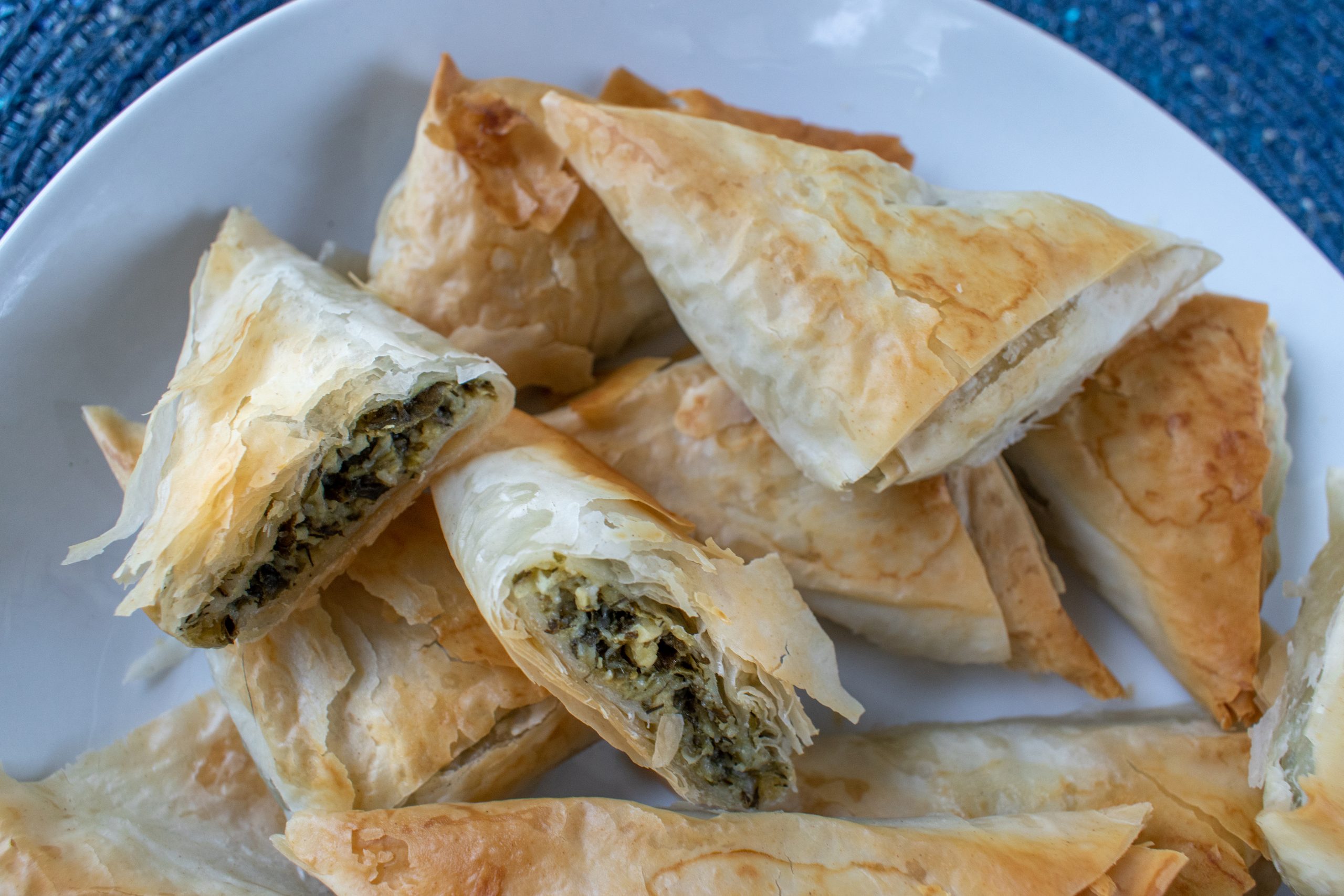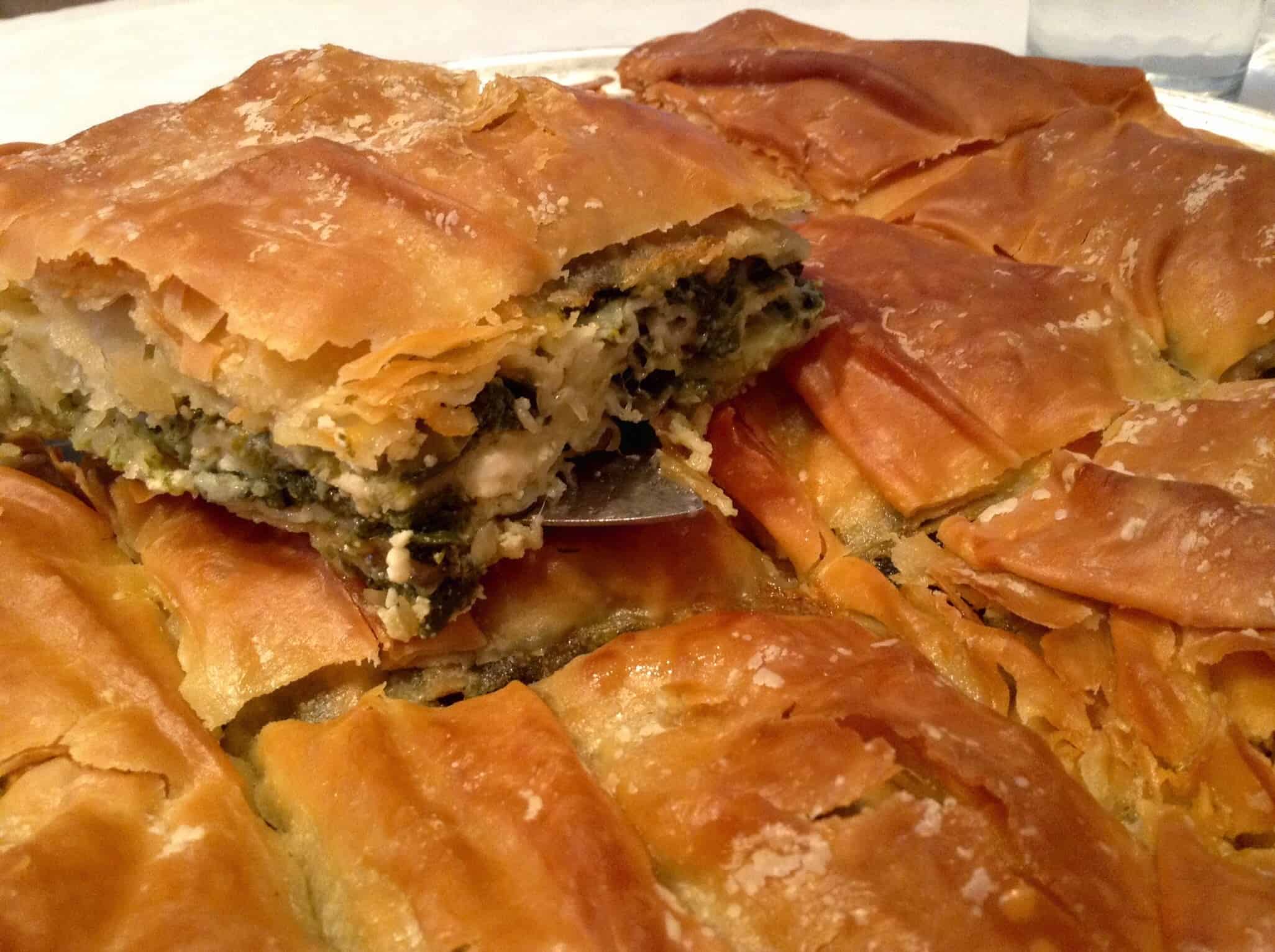Menu
Install the app
How to install the app on iOS
Follow along with the video below to see how to install our site as a web app on your home screen.
Note: This feature may not be available in some browsers.
You are using an out of date browser. It may not display this or other websites correctly.
You should upgrade or use an alternative browser.
You should upgrade or use an alternative browser.
Greek Food, Cooking and Recipe Community
Just attempted my first spanakopita!
- Thread starter nadellii
- Start date
1 - 7 of 7 Posts
WOW! This looks amazing for a first time making spanakopita!
Just in case you want to compare, here are a few recipes for spanakopita:

Greek Spinach Pie Spanakopita Recipe
Here is an easy spanakopita recipe that is the perfect appetizer for your family or at your next party!

Spanakopita - Athens Foods

Spanakopita recipe with homemade phyllo (Authentic Greek spinach pie)
The traditional Greek spanakopita recipe (spinach pie) with crispy phyllo and juicy spinach stuffing! Discover how to make it to perfection just like yiayia
Patisqua
Member
Bravo sou. I use a Jamie Oliver recipe for Spinach Naan. Suits my almost non existence cooking skills.
greek_ggirl
Active member
Can you share the recipe? I can't find it on googleBravo sou. I use a Jamie Oliver recipe for Spinach Naan. Suits my almost non existence cooking skills.
Patisqua
Member
Can you share the recipe? I can't find it on google
Really? I have attached the recipe. The blue text suits a larger oven proof frypan. A friend uses the mixture when she makes spinach triangles with filo pastry. Καλή όρεξη.Can you share the recipe? I can't find it on google
Attachments
francescool
Active member
This looks great, I will attempt this as wellReally? I have attached the recipe. The blue text suits a larger oven proof frypan. A friend uses the mixture when she makes spinach triangles with filo pastry. Καλή όρεξη.
k_tsoukalas
Administrator
This looks delicious! Looks like it is cooked perfectly and I love it when the top gets crispy and flaky like that...
1 - 7 of 7 Posts
JOIN THE DISCUSSION AND READ OTHER GREEK INFO:
Making traditional loukaniko question
- GreekGirlCooks
- Greek Food Forum
- Replies: 0
I’m on a culinary quest to master the art of making Loukaniko, the traditional Greek sausage that tantalizes taste buds with its savory blend of spices and herbs. I understand that each region and even each family might have their own special recipe passed down through generations.
Which leads me to my ask - could anyone who’s familiar with Greek cuisine share insights about the most common seasonings used in Loukaniko? I'm especially interested in any mix of spices that gives it that characteristic flavor profile.
I’ve done some preliminary research, but I’m looking for that firsthand knowledge. What's the blend that makes your Loukaniko stand out? Are there any particular secrets to perfect the authentic taste?
Which leads me to my ask - could anyone who’s familiar with Greek cuisine share insights about the most common seasonings used in Loukaniko? I'm especially interested in any mix of spices that gives it that characteristic flavor profile.
I’ve done some preliminary research, but I’m looking for that firsthand knowledge. What's the blend that makes your Loukaniko stand out? Are there any particular secrets to perfect the authentic taste?
Enjoying Cooking with Greek Honey
- axariotisxy
- Greek Food Forum
- Replies: 1
One of the things I love most about Greek honey is its versatility. You can use it in so many different ways in the kitchen. I've drizzled it over Greek yogurt for breakfast, mixed it into salad dressings for a touch of sweetness, and even used it as a glaze for roasted vegetables. The depth of flavor it adds to dishes is truly remarkable.
But perhaps my favorite way to use Greek honey is in baking. It adds a wonderful depth of flavor to cakes, cookies, and pastries. I recently made a batch of baklava using Greek honey, and it was a game-changer. The honey soaked into the layers of phyllo dough, creating a sweet and sticky treat that was absolutely irresistible.
I go out of my way to buy it - if I can't find it locally, I get it online. When I go to Greece, I get some in Greece, too.
What do you love to use Greek honey for?

But perhaps my favorite way to use Greek honey is in baking. It adds a wonderful depth of flavor to cakes, cookies, and pastries. I recently made a batch of baklava using Greek honey, and it was a game-changer. The honey soaked into the layers of phyllo dough, creating a sweet and sticky treat that was absolutely irresistible.
I go out of my way to buy it - if I can't find it locally, I get it online. When I go to Greece, I get some in Greece, too.
What do you love to use Greek honey for?

What is the best street food in Greece?
- kosta_karapinotis
- Greek Food Forum
- Replies: 2
What do you consider the best street food in Greece? Are there any specific dishes or local delicacies that you dream of having again? Also, if you have recommendations for particular places or vendors, that would be fantastic!
Here's what I've got on my list so far:
Here's what I've got on my list so far:
- Souvlaki
- Gyros
- Loukoumades
- Spanakopita
- Bougatsa
What are the most famous Greek cheeses?
- knicks_fan87
- Greek Food Forum
- Replies: 0
I've recently embarked on a culinary quest to explore the rich and diverse world of Greek cheeses. From the tangy feta found in traditional Greek salads to the sizzling delights of halloumi, Greece's cheese culture seems incredibly vast and flavorful. 
I'm reaching out to this knowledgeable community to ask: What are the most famous Greek cheeses that you've tried or heard of?
Are there any particular varieties that are a must-try or any hidden gems that rarely escape the borders of Greece? And if you have any delicious recipes or pairings to share, I'd love to hear about those too!
I'm reaching out to this knowledgeable community to ask: What are the most famous Greek cheeses that you've tried or heard of?
Are there any particular varieties that are a must-try or any hidden gems that rarely escape the borders of Greece? And if you have any delicious recipes or pairings to share, I'd love to hear about those too!
Greek Halva Recipe to Enjoy During Lent?
- d_kakavouli
- Greek Food Forum
- Replies: 2
I love Halva year round but I often see it a lot during Lent. My recipe doesn't seem Lent friendly to me. Any ideas on how I can adapt it?
Ingredients:
Ingredients:
- 1 cup semolina
- 1 cup granulated sugar
- 1/2 cup unsalted butter
- 2 cups water
- 1/4 teaspoon ground cinnamon
- 1/4 cup chopped almonds or walnuts (optional)
- 1/4 cup raisins (optional)
- In a medium-sized saucepan, melt the butter over medium heat.
- Add the semolina to the melted butter and stir continuously for about 5-7 minutes, or until the semolina turns golden brown and begins to emit a nutty aroma.
- While stirring the semolina mixture, gradually add the sugar and continue to cook for another 2-3 minutes until the sugar is fully incorporated.
- Slowly pour in the water, stirring constantly to avoid lumps from forming. Be careful as the mixture may splatter.
- Reduce the heat to low and continue stirring the mixture until it thickens to a porridge-like consistency, about 5-7 minutes.
- Stir in the ground cinnamon and optional chopped nuts and raisins, if using.
- Remove the saucepan from the heat and let the halva rest for a few minutes to thicken further.
- Serve the halva warm or at room temperature, either as a dessert or a sweet breakfast treat.
Sign up for a free account and share your thoughts, photos, questions about Greek food, travel and culture!
WorldwideGreeks.com is a free online forum community where people can discuss Greek food, travel, traditions, history and mythology.
Join Worldwide Greeks here!
Join Worldwide Greeks here!
JOIN COMMUNITY FOR FREE
LOGIN TO YOUR ACCOUNT



